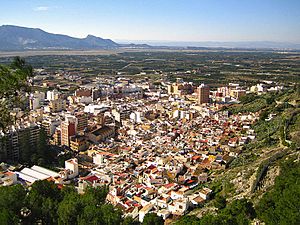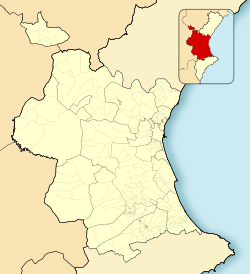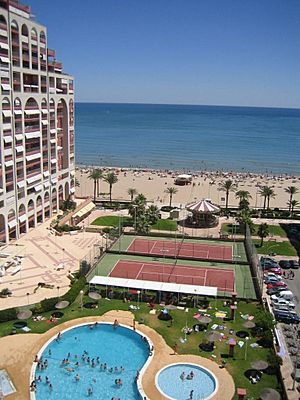Cullera facts for kids
Quick facts for kids
Cullera
|
|||
|---|---|---|---|
 |
|||
|
|||
| Country | Spain | ||
| Autonomous community | Valencian Community | ||
| Province | Valencia | ||
| Comarca | Ribera Baixa | ||
| Area | |||
| • Total | 53.8 km2 (20.8 sq mi) | ||
| Elevation | 2 m (7 ft) | ||
| Population
(2018)
|
|||
| • Total | 21,918 | ||
| • Density | 407.4/km2 (1,055.2/sq mi) | ||
| Demonym(s) | Cullerenc, cullerenca Cullerà, cullerana |
||
| Time zone | UTC+1 (CET) | ||
| • Summer (DST) | UTC+2 (CEST) | ||
| Postal code |
46400
|
||
Cullera is a lively city and municipality in Spain. It's located in the Valencian Community, which is a region in eastern Spain. Cullera is part of the province of Valencia and the Ribera Baixa area. The city is special because it sits right where the Júcar river meets the beautiful Mediterranean Sea.
Contents
Geography of Cullera
Cullera is about 40 kilometers (25 miles) from Valencia, the capital city of the region. It's also 56 kilometers (35 miles) from Valencia's international airport.
Areas and Hamlets
Cullera has several different parts and smaller communities, often called hamlets. Some of these include:
- El Brosquil
- Cullera-Park
- Cap-Blanc
- El Dosel
- El Estany
- El Marenyet
- Mareny de San Lorenzo
- Mareny Blau
- Bega de Mar
- El Perelló
Neighboring Cities
Cullera shares its borders with several other cities, all located in the Valencia province. These include Sueca, Corbera, Llaurí, Favara, Alzira, and Tavernes de Valldigna.
Cullera's Mountain and Lagoon
Cullera is known for its mountain, called Munt de l'Or or Muntanya de l'Or. This mountain is the very last part of the Iberian System mountain range before it reaches the Mediterranean Sea. It stands at 233 meters (764 feet) tall. The older, historic parts of the city are on the south side of the mountain, while the newer tourist areas face the sea to the east.
To the north of the mountain, you'll find the San Lorenzo lagoon. This small lake used to be part of a much larger lake. Over time, much of the land was drained to create farms. Today, the lagoon marks the southern edge of the Parc Natural de l'Albufera, a protected natural park.
Economy in Cullera
For a long time, Cullera's economy was mostly about farming. Important crops grown here include rice and oranges. Fishing was also a big part of the economy.
However, in recent years, tourism has become very important. Many people from Spain and other countries visit Cullera for its beaches and attractions. This has made tourism a major part of the city's economy. Cullera also has a port called Puerto de Cullera, which is connected to a local fish market known as Lonja de Cullera.
Historical and Artistic Places
Cullera has many interesting places to visit that show its long history and culture.
- Castle: High up on the mountain, overlooking the city and the sea, stands a fortress built in the 13th century. It was built on top of an even older Moorish fortress. While the original walls are mostly gone, you can still see parts of the old towers that were once part of the walled area on the mountain.
- Sanctuary of the Virgen del Castillo': (19th century) Inside the castle area, there is a special church called the sanctuary of the Virgen del Castillo. A festival celebrating the Virgin is held here the week after Passover each year.
- Church of the Saint Johns: This church was built in the 17th century in a style called neoclassical. It stands on the site of an even older Gothic church. The church has been carefully restored and is a beautiful example of old architecture.
- Torre del marenyet': This is an old watchtower that was built in the 15th century. Its job was to watch over the Júcar river and protect the area from barbary pirates.
- Cave of Dragut: This cave tells the story of an invasion by Berbers in Cullera. Legend says that the famous pirate Dragut once stayed here.
- Air-raid shelter-Museum of the Mercat Municipal': This unique museum is actually a bomb shelter built under the Town's Market. It was constructed during the Spanish Civil War to protect people from air raids.
- Hermitage of the stone saints (Abdon and Sennen): This building is located on a hill surrounded by rice fields. It was built in the 18th century and was dedicated to two saints who were believed to help protect crops. Today, this hermitage has been turned into a museum all about rice, showing different types of rice, how it's grown, and the tools used. Rice is very important in Valencian cuisine.
- Abric Lambert cave paintings: These ancient paintings were found by Lambert Oliver on the northwest side of Cullera's mountain. The paintings show several figures in dark red, including cross-shaped and comb-shaped designs. Experts believe these figures represent animals and people.
Images for kids
Sister Cities
Cullera has special connections with cities in other countries, called "twin towns" or "sister cities":
 Le Bourget, France (since 1982)
Le Bourget, France (since 1982) Ouroux-en-Morvan, France
Ouroux-en-Morvan, France Jever, Germany (since 1998)
Jever, Germany (since 1998) Syktyvkar, Russia
Syktyvkar, Russia
See also
 In Spanish: Cullera para niños
In Spanish: Cullera para niños










